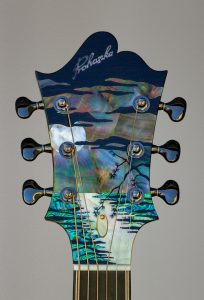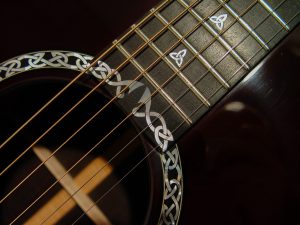 Custom inlays for guitars are decorative elements that can be inserted in the fretboard, headstock, or body of a guitar to enhance its appearance and uniqueness and are a popular way for guitarists to personalize their instruments and add a unique touch to their appearance. These inlays can be made from various materials, such as mother-of-pearl, abalone, wood, metal, or synthetic materials, and they come in a wide range of designs and patterns. They can take many forms, including intricate designs, patterns, logos, or even personalized artwork.
Custom inlays for guitars are decorative elements that can be inserted in the fretboard, headstock, or body of a guitar to enhance its appearance and uniqueness and are a popular way for guitarists to personalize their instruments and add a unique touch to their appearance. These inlays can be made from various materials, such as mother-of-pearl, abalone, wood, metal, or synthetic materials, and they come in a wide range of designs and patterns. They can take many forms, including intricate designs, patterns, logos, or even personalized artwork.
Inlay Process
Craftsmanship
 Custom inlays require skilled craftsmanship to create and install. Many professional luthiers or guitar makers offer custom inlay services. It’s important to choose an experienced artisan who can accurately translate your design ideas into a beautiful inlay.
Custom inlays require skilled craftsmanship to create and install. Many professional luthiers or guitar makers offer custom inlay services. It’s important to choose an experienced artisan who can accurately translate your design ideas into a beautiful inlay.
Cost and Time
The cost of custom inlays varies depending on the complexity of the design, the materials used, and the expertise of the artisan. More intricate and detailed designs with precious materials can be quite expensive, but they can also add significant value and character to your guitar. Custom inlays take time to design, create, and install, so be prepared for a longer production time if you opt for these personalized elements on your guitar.
Design
 The first step is to design the custom inlay. This can be done by the guitar owner, a luthier, or a specialized inlay artist. The design of the inlay is highly customizable. You can choose various designs, including traditional shapes like dots, diamonds, or block inlays, or more intricate and personalized designs, such as animals, logos, vines, symbols personal initials or intricate scenes. Software programs or hand-drawn sketches are used for the design. Many luthiers and guitar manufacturers offer standard design options, but you can also commission a custom design to make your guitar truly unique.
The first step is to design the custom inlay. This can be done by the guitar owner, a luthier, or a specialized inlay artist. The design of the inlay is highly customizable. You can choose various designs, including traditional shapes like dots, diamonds, or block inlays, or more intricate and personalized designs, such as animals, logos, vines, symbols personal initials or intricate scenes. Software programs or hand-drawn sketches are used for the design. Many luthiers and guitar manufacturers offer standard design options, but you can also commission a custom design to make your guitar truly unique.
Placement
![]() Inlays can be placed on the fretboard, headstock, or the body of the guitar. Fretboard inlays are the most common and are typically located on the fingerboard to help players navigate the frets. Headstock inlays are often used to display the guitar brand or model name. Body inlays, such as rosettes around the soundhole, are more decorative and less functional.
Inlays can be placed on the fretboard, headstock, or the body of the guitar. Fretboard inlays are the most common and are typically located on the fingerboard to help players navigate the frets. Headstock inlays are often used to display the guitar brand or model name. Body inlays, such as rosettes around the soundhole, are more decorative and less functional.
Material Selection
Once the design is finalized, you’ll need to choose the material for the inlay. Mother-of-pearl and abalone are popular choices due to their iridescent qualities, while wood inlays can provide a more subtle and natural look but other materials can also be used. The material choice can affect the cost and appearance of the inlay.
Cutting and Shaping
The selected inlay material is then cut and shaped to match the design. Precision tools are used to create the individual inlay pieces.
Fretboard or Headstock Preparation
The guitar’s fretboard or headstock is prepared to receive the inlays. This may involve routing or carving out cavities to fit the inlay pieces securely.
Inlay Installation
The custom inlay pieces are carefully installed into the prepared cavities. Glue or epoxy is often used to hold them in place.
Finishing
After the inlays are securely set, the guitar is refinished to ensure a smooth, even surface that is level with the surrounding wood.
Fret Dressing
In some cases, frets may need to be dressed or replaced to ensure they are level with the new inlays and that the playability of the guitar is not affected.
Final Setup
The guitar is set up to ensure proper intonation, action, etc.
Maintenance
Inlays, particularly those on the fretboard, may require occasional cleaning to maintain their appearance and functionality. Gently wiping them down with a soft, damp cloth and keeping your guitar in a suitable case when not in use can help preserve the inlays. Your luthier or installer should be able to give you information on keeping your inlay looking good.
Whether you’re a professional musician looking for a one-of-a-kind instrument or a guitar enthusiast who wants to personalize their instrument, custom inlays can be a beautiful addition to your guitar. They allow you to express your personality and style while also showcasing the craftsmanship and artistry of the luthier who creates them.